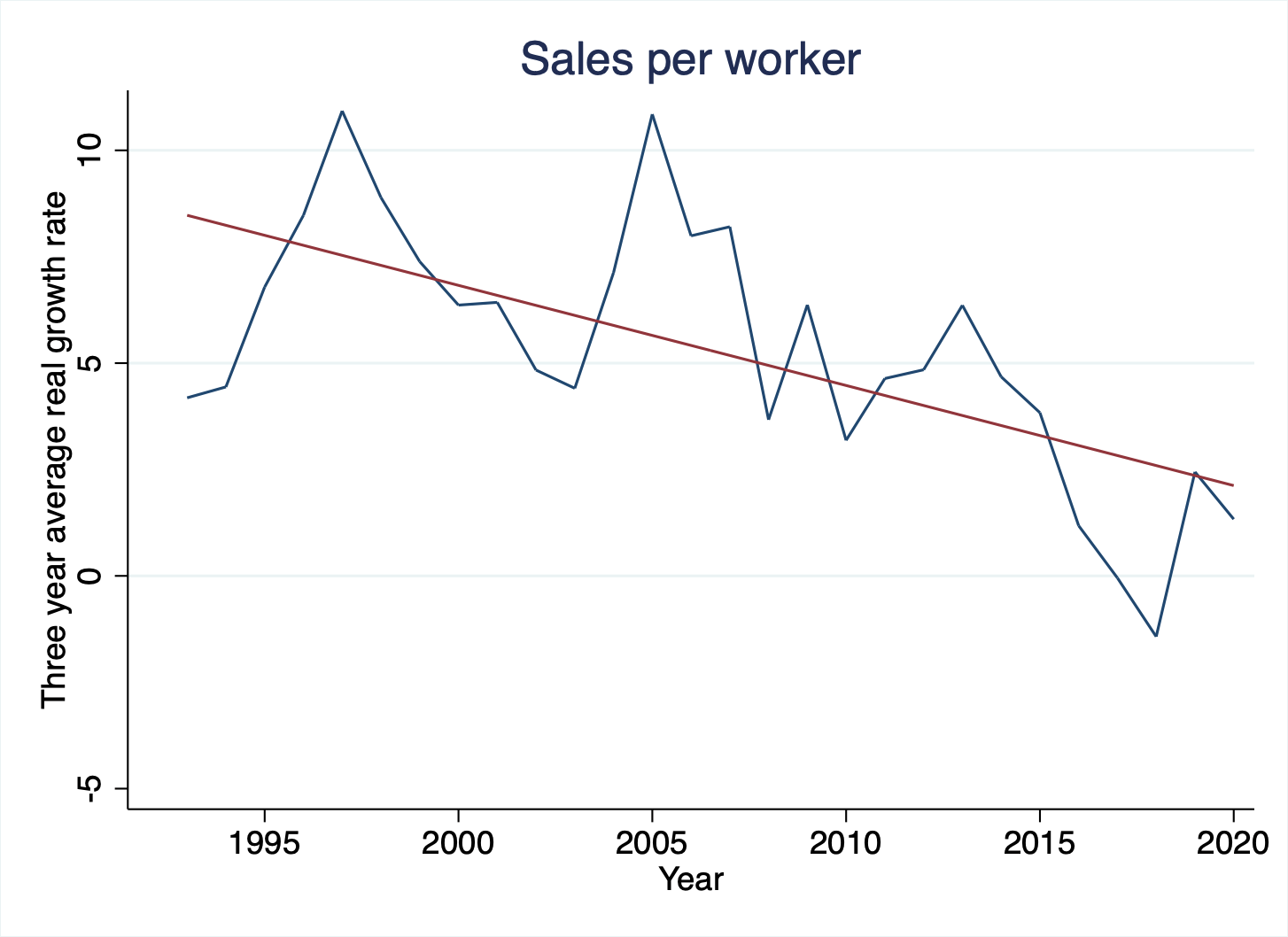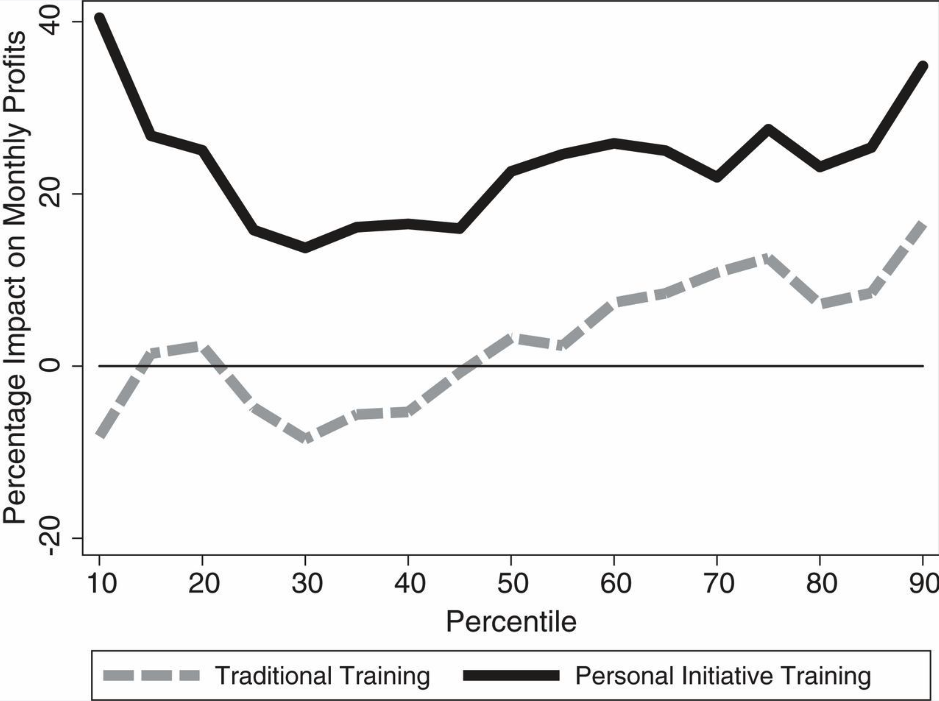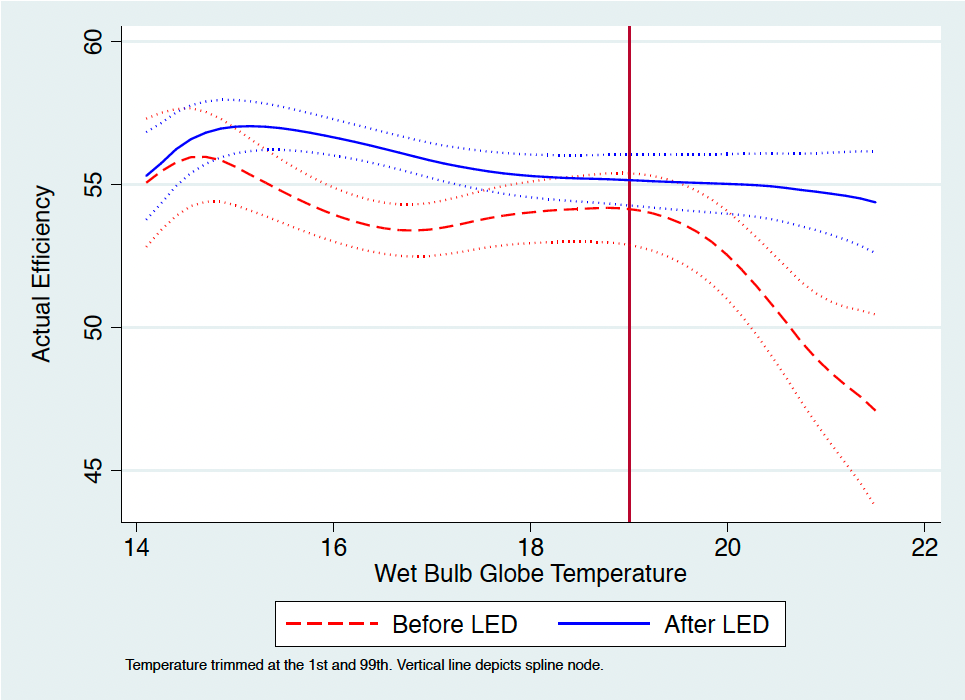In the second article in the Ideas@IPF2023 series, Adhvaryu et al. synthesise some facts on India’s declining manufacturing productivity and variations across states and industries. They examine existing literature on investments in four key areas with the potential to increase worker productivity – soft skills, voice, physical environment, and managerial quality – highlighting studies conducted in both the Indian and global context. They conclude with possible reasons why firms may not be adequately investing in workers.
India’s manufacturing sector is widely held as a key to the ongoing structural transformation of its economy, the pathway for millions of low-income Indians to grow their incomes out of poverty, and India’s overall economic competitiveness on the global stage (Aggarwal and Kumar 2015). Indian manufacturing is particularly important given the accelerating global demand to shift supply chains away from China (Ghosh and Mukherji 2020). The United States, the EU countries, and other large economies view India as a prime destination where key aspects of global production could move. But absorbing this potential demand will require a massive expansion of manufacturing capacity within India. Raising manufacturing’s share of GDP in the coming decade is a key stated goal of the Government of India. The government’s ‘Make in India’ push – to reduce dependence on China and other major sources of imports – also aligns with the emphasis on manufacturing growth (Anand et al. 2015). These goals consequently imply that manufacturing productivity is of critical importance as India wishes to position itself as a major player in the global ‘friendshoring’ trend, as well as for India’s own desire to be more self-reliant in the production of consumer goods.
Stylised facts on manufacturing productivity in India
We examine trends in India’s manufacturing productivity, with the goal of establishing some basic stylised facts related to aggregate productivity growth and the dispersion in productivity across states and industries.
Our takeaway from these statistics is that the growth in manufacturing productivity – as measured by sales per worker – has slowed considerably in the past decade, particularly in the years leading up to the start of the Covid-19 pandemic in 2020. To elaborate, data from the Annual Survey of Industries (ASI) illustrates a strong decline in manufacturing productivity growth since the 1990s, with an acceleration of this decline starting in the mid-2010s (see Figure 1). The growth rate, which oscillated between 10 to 15% in the 1990s and 2000s, began to stagnate post-2015, indicating an alarming slowdown in the productivity growth of Indian manufacturing firms.
Figure 1. Three-year moving average of aggregate annual productivity growth in manufacturing, 1990 to 2020
Consistent with a large literature, Indian manufacturing productivity is significantly lower than that of the United States. In 2020, Indian productivity ($94,249 per worker) was approximately a fifth of the US levels ($484,862 per worker), or three-fifths when adjusting for differences in purchasing power parities (ASI, 2019-20, US Bureau of Labor Statistics, 2021). We also see a considerable heterogeneity in productivity across Indian states: states in Western and Central India tend to have the highest average productivity, while states in the East and South have the lowest. These cross-state differences persist when controlling for state industrial composition.
The data illustrates significant dispersion in manufacturing productivity across different Indian states, but also within industries. For example, the average sales per worker in the 10th percentile amounts to approximately $24,000, compared to $145,000 in the 90th percentile. These differences hold even after adjusting for the composition of industries within each state, indicating that factors beyond industrial composition are driving these differences. More generally, in alignment with the large economics literature on productivity dispersion, the difference in productivity across the most and least productive firms is vast in India, even after controlling for state and industry effects.
The presented stylised facts spotlight the idea that making strategic investments in the workforce can potentially lead to substantial improvements in productivity. They also suggest that addressing the substantial disparities in productivity across different states and industries is imperative for the sustainable development of India’s manufacturing sector.
Evidence on the impacts of investments in workers
The positive correlation between investments in workers and productivity is substantial, but it’s important to recognise that this relationship may not be causal. Factors such as unobserved firm choices could be linked to both the provision of wages and benefits to employees and productivity. We delve into several categories of investment in workers, and assess the causal evidence of their impacts on productivity through a review of studies employing prospective randomised controlled trials (RCTs) or using credibly exogenous variation.
i) Soft skills: One of the focal areas of investment is in enhancing soft skills among workers. Soft skills such as communication, time management, problem-solving, and teamwork have been shown to have significant contributions to productivity and labour earnings (Heckman et al. 2006, Borghans et al. 2008, Groh et al. 2012, Heckman and Kautz 2012, Guerra et al. 2014, Deming 2017, Montalvao et al. 2017, Bassi and Nansamba 2022). This is especially crucial in the manufacturing sector, where traditionally the emphasis has been on technical skills. Programmes like the Personal Advancement and Career Enhancement (P.A.C.E.) programme in India, which trains female garment workers in soft skills, have demonstrated improvements in retention rates and increases in productivity by as much as seven percentage points (Adhvaryu et al. 2022b).
The linkage between training and productivity has been established quite convincingly in other countries through RCTs. For example, a study by Campos et al. (2017) evaluated how improvements in the soft skills of micro-entrepreneurs through a psychology-based personal initiative training program – that teaches a proactive mindset and focuses on entrepreneurial behaviors – compared to traditional business training increased their sales by 17% and their profits by 30% over two years when compared to the control group in Togo, West Africa.
Figure 2: Quantile treatment effects of soft skills training on monthly profits of micro-entrepreneurs
Similarly, in the Netherlands, De Grip and Sauermann (2012) tested the impact of providing soft skills training to call-center employees in the Netherlands. Employees in the treatment group, who were taught various skills, including problem-solving, working under pressure, and effectively dealing with customer grievances received 10% higher ratings from customers than those in the control group.
ii) Worker voice: Another aspect explored is the voice of employees within the organisation. Encouraging employees to voice their concerns can strengthen the relationship between them and their employers, which leads to increased productivity by reducing turnover, motivating employees, and improving communication.
For example, after a disappointingly small statutory minimum wage increase in 2016, Adhvaryu et al. (2022c) conducted an RCT within a ready-made garment firm to understand the importance of furthering workers' voices, especially during times of general discontent within a workplace. Workers were asked at random to fill out a feedback survey in which they were asked about their feelings regarding their supervisors, overall worker satisfaction, satisfaction with the firm, their wages, and their jobs. The treatment effect estimates show that enabling workers' voices reduced the probability of quitting by 20 percentage points in the months following the wage hike.
Similarly, when auto workers in China participated in evaluating their managers, it resulted in a 50% reduction in turnover, raising overall productivity and employee happiness (Cai and Wang 2022). Implementing an SMS-based communication tool in Indian garment factories led to reduced absenteeism and attrition by 5% and 10%, respectively, improving productivity by 7.2% (Adhvaryu et al. 2021, 2023a).
iii) Environmental conditions: The physical environment and working conditions are also key areas of investment. Pollution and extreme heat can have detrimental effects on workers' health, subsequently impacting productivity. Somanathan et al. (2021), for example, studied the effects of rising temperatures on worker productivity in Delhi and Gujarat, focussing on how these effects vary for manual labourers and labourers in automated manufacturing settings. They found that for a one-degree celsius increase in temperature, productivity saw a 2% reduction.
Meanwhile, a study by Adhvaryu et al. (2020) found that by adopting cooling technologies and energy-saving methods, like LED lighting, Indian garment firms created a conducive working environment that positively impacted productivity, and reduced by 85% the negative impact of temperature on hot days (see Figure 3). This led to firm-wise productivity increases and shifted the overall break-even point for the firm from over three and a half years to less than eight months.
Figure 3. Worker efficiency as a function of temperature
Adhvaryu et al. (2022a) studied how workers' productivity varied in the presence of fine particulate matter, a type of air pollution in garment factories across Delhi. The results show that fairly sizable particulate matter pollution shocks are commonplace and that worker- and line-level productivity suffer during these shocks – a one-standard-deviation increase in pollution decreases efficiency by half a point. Further event study analysis confirms that large pollution shocks immediately affect worker productivity, with impacts varying across the tasks the worker performs and the worker themselves; impacts are 60% larger for workers performing complex tasks and 35% larger for older workers.
iv) Managerial quality: Managerial quality is another critical area of investment. Customised training focussing on leadership and communication skills of garment production managers has been shown to enhance productivity by as much as 6%, and trained managers are 15% less likely to quit (Adhvaryu et al. 2023a, 2023b).
For instance, an RCT by Macchiavello et al. (2020) conducted in garment factories in Bangladesh found that when ‘marginal’ male and female were promoted to supervisor positions, female supervisors initially had lower productivity and evaluation from subordinate workers than their male counterparts. This initial worse performance stemmed from negative beliefs about the abilities of female supervisors, but these gaps disappeared after 4-6 months.
Effective managerial practices such as performance monitoring, information sharing, and focussing on long-term impacts can lead to increased productivity through improved quality, efficiency, and organisational learning. However, it’s important to note that there may be resistance to changing practices, and programmes must be carefully designed to align with the firm’s specific needs and the skill levels of the managers.
Barriers for firms to invest in workers
Investments in employees – encompassing soft skills, employee voice, environmental conditions, health, and managerial quality – have all been shown to have potential causal impacts on productivity which can be encompassed in carefully designed interventions that consider the specific needs and contexts of the firms.
However, for a variety of reasons, firms may underinvest in their employees. One notable barrier is information friction: firms might either lack awareness or underestimate the potential benefits of investing in employees. In particular, information about the advantages of investment might not reach the relevant decision-makers within the firm, due to communication hurdles. Another impediment potentially is the risk-averse nature of decision-makers who owing to uncertainty in investment outcomes, may hesitate to make potentially profitable investments, especially in resource-constrained settings.
Managerial attention can also be an important limiting factor. The plethora of responsibilities that managers have oversight of often means that adequate attention is not given to evaluating and implementing strategies for worker investments. Another likely barrier is the misalignment of incentives across different levels within the firm. The varied interests within the organisation might lead to resistance or slow the adoption of profitable practices if they don't align with the interests of certain individuals or departments.
Moreover, high employee turnover rates can make firms reluctant to invest in employee training, particularly in general skills that are transferable, as they may not see immediate benefits from these investments. Market dynamics also play a role here since in highly competitive labour markets, firms might be disincentivised from investing in training as employees might use these skills to move to other companies.
Understanding and addressing these barriers and market factors is essential to encourage firms to invest in their workforce. There is an imperative need for more in-depth research to fully understand firm behaviour in relation to employee investment – both to develop a larger menu of productivity-improving investments through rigorous causal studies, and to study the barriers and understand how policy can make it easier for firms to adopt more worker investments – to unlock better productivity and mutual benefits for both firms and employees.
This is a summary of a preliminary paper draft prepared for the NCAER India Policy Forum 2023.
Further Reading
- Adhvaryu, Achyuta, Namrata Kala and Anant Nyshadham (2020), “The light and the heat: Productivity co-benefits of energy-saving technology”, Review of Economics and Statistics, 102(4): 779-792.
- Adhvaryu, A, S Gade, T Molina and A Nyshadham (2021), ‘Sotto Voce: The Impacts of Technology to Enhance Worker Voice’, Working Paper. Available here.
- Adhvaryu, Achyuta, Namrata Kala and Anant Nyshadham (2022a), “Management and shocks to worker productivity”, Journal of Political Economy, 130(1): 1-47.
- Adhvaryu, Achyuta, Namrata Kala and Anant Nyshadham (2022b), “Returns to on-the-job soft skills training”, Journal of Political Economy, forthcoming.
- Adhvaryu, Achyuta, Teresa Molina and Anant Nyshadham (2022c), “Expectations, Wage Hikes and Worker Voice”, The Economic Journal, 132(645): 1978-1993.
- Adhvaryu, A, S Gade, T Molina and A Nyshadham (2023a), ‘Call and Response: The Business Impacts of Systems to Improve Worker Voice’, Working Paper.
- Adhvaryu, A, E Murathanoglu and A Nyshadham (2023b), ‘On the allocation and Impacts of Managerial Training’, NBER Working Paper 31335.
- Aggarwal, A and N Kumar (2015), Structural change, industrialization, and poverty reduction. In Structural change and industrial development in the BRICS, Oxford University Press, Oxford.
- Anand, R, MK Kochhar and MS Mishra (2015), ‘Make in India: Which exports can drive the next wave of growth?’, International Monetary Fund Working Paper No. 2015/119.
- Bassi, Vittorio and Aisha Nansamba (2022), “Screening and signalling non-cognitive skills: experimental evidence from Uganda”, The Economic Journal, 132(642): 471-511.
- Borghans, Lex, Angela Lee Duckworth, James J Heckman, J.J. and Bas Ter Weel (2008), “The economics and psychology of personality traits”, Journal of Human Resources, 43(4): 972-1059.
- Cai, Jing and Shing-Yi Wang (2022), “Improving management through worker evaluations: Evidence from auto manufacturing”, The Quarterly Journal of Economics, 137(4): 2459-2497.
- Campos, Francisco, et al. (2017), “Teaching personal initiative beats traditional training in boosting small business in West Africa, Science, 357(6357): 1287-1290.
- De Grip, Andries and Jan Sauermann (2012), “The effects of training on own and co‐worker productivity: Evidence from a field experiment”, The Economic Journal, 122(560): 376-399.
- Deming, David J (2017), “The growing importance of social skills in the labor market”, The Quarterly Journal of Economics, 132(4): 1593-1640.
- Ghosh, M and B Mukherji (2020), ‘Global firms look to shift from China to India’, Mint, 22 April.
- Groh, M, N Krishnan, DJ McKenzie and T Vishwanath (2012), ‘Soft skills or hard cash? The impact of training and wage subsidy programs on female youth employment in Jordan’, World Bank Policy Research Working Paper 6141.
- Heckman, James J and Tim Kautz (2012), “Hard evidence on soft skills”, Labour Economics, 19(4): 451-464.
- Heckman, James J, Jora Stixrud and Sergio Urzua (2006), “The effects of cognitive and noncognitive abilities on labor market outcomes and social behavior”, Journal of Labor Economics, 24(3): 411-482.
- Macchiavello, R, A Menzel, A Rabbani and C Woodruff (2020), ‘Challenges of change: An experiment promoting women to managerial roles in the Bangladeshi garment sector’, NBER Working Paper 27606.
- Montalvao, J, M Frese, M Goldstein, T Kilic, and MD Frese (2017), ‘Soft skills for hard constraints: Evidence from high-achieving female farmers’, World Bank Policy Research Working Paper 8095.
- Somanathan, E, Rohini Anant Sudarshan and Meenu Tewari (2021), “The impact of temperature on productivity and labor supply: Evidence from Indian manufacturing”, Journal of Political Economy, 129(6): 1797-1827.




 12 July, 2023
12 July, 2023 











Comments will be held for moderation. Your contact information will not be made public.